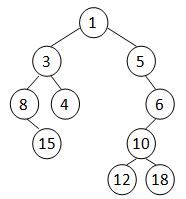PAT甲 7-4 Cartesian Tree (30分) 两种解法
7-4 Cartesian Tree (30分)
A Cartesian tree is a binary tree constructed from a sequence of distinct numbers. The tree is heap-ordered, and an inorder traversal returns the original sequence. For example, given the sequence { 8, 15, 3, 4, 1, 5, 12, 10, 18, 6 }, the min-heap Cartesian tree is shown by the figure.
Your job is to output the level-order traversal sequence of the min-heap Cartesian tree.
Input Specification:
Each input file contains one test case. Each case starts from giving a positive integer N (≤30), and then N distinct numbers in the next line, separated by a space. All the numbers are in the range of int.
Output Specification:
For each test case, print in a line the level-order traversal sequence of the min-heap Cartesian tree. All the numbers in a line must be separated by exactly one space, and there must be no extra space at the beginning or the end of the line.
Sample Input:
10
8 15 3 4 1 5 12 10 18 6
Sample Output:
1 3 5 8 4 6 15 10 12 18
思路:
利用最小堆的性质,根为当前子树最小的值,得到根的下标,而中序遍历为LNR,得到根下标即可分开左子树和右子树。
方法一:建树+BFS即可,详见代码。
方法二:不必建树,在遍历得到根节点的同时记录树深度,并将各层节点存入深度数字level[ ], 之后从遍历0~最深层依次输出即可。
Code(方法一):
#include
#include
#include
#include Code(方法二):
#include
#include
#include
#include
using namespace std;
const int INF = 0x3fffffff;
const int maxn = 210;
struct node{
int data;
node* lchild,*rchild;
node(int x){
data = x; lchild = rchild = NULL;
}
};
vector in;
int find_min(int L,int R){
int Min = INF,index = -1;
for(int i = L; i <= R; i++){
if(in[i] < Min){
Min = in[i];
index = i;
}
}
return index;
}
int MaxH = -1;
vector level[maxn];
void build(int L,int R,int height){
if(L > R) return ;
if(height > MaxH) MaxH = height;
int X = find_min(L,R);
level[height].push_back(in[X]);
build(L,X-1,height+1);
build(X+1,R,height+1);
}
int cnt = 0,n;
int main(){
scanf("%d",&n);
in.resize(n);
for(int i = 0; i < n; i++)
scanf("%d",&in[i]);
build(0,n-1,0);
for(int i = 0; i <= MaxH; i++){
if(i == 0){
printf("%d",level[i][0]);
}
else {
for(int j = 0; j < level[i].size();j++)
printf(" %d",level[i][j]);
}
}
printf("\n");
return 0;
}

